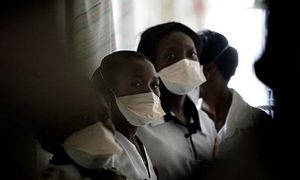
|
| ©Gianluigi Guercia/AFP |
| Nurses wait to treat patients in the Sizwe hospital TB ward in Edenvale on the outskirt of Johannesburg, South Africa. |
Doctors have diagnosed the first ever UK case of a virtually untreatable strain of tuberculosis, marking a further step in the disease's fightback against the antibiotics that once kept it in check. A man in his 30s is in isolation at a hospital in Glasgow and is being treated with a cocktail of antibiotics in an effort to control the extreme drug-resistant tuberculosis (XDR-TB), the Guardian has learnt.
A spokeswoman at Gartnavel general hospital confirmed the case and said health officers were tracing people who may have come into close contact with the man.
This is the first time a patient has been diagnosed and treated for XDR-TB in the UK. The World Health Organisation has warned of the danger that XDR-TB poses because of the ease with which the airborne disease can travel in an era of mass migration and global travel.
Tuberculosis is spread only through close and prolonged contact with other people, such as in a family or among children in a school, so there is no suggestion that a single case could spark an epidemic. The arrival of XDR-TB in the UK is, however, a warning of the need for greater vigilance against the disease.
"XDR-TB is an extremely serious form of TB," said Professor Peter Davis, a Liverpool consultant and secretary of TB Alert in the UK. "It is quite prevalent in other parts of the world. We have got to be aware of it." Drugs could contain the disease, but not cure it, he said. About half of those who were infected would survive.
Strains of TB which are resistant to the two main antibiotics used to treat it have been spreading across the globe and complicating treatment for some years. About 1% of the 8,497 cases reported in the UK in 2006 showed multiple drug resistance.
XDR-TB, however, is a new and still more alarming phenomenon, showing resistance to both first and second-line drugs. Treatment takes 12 to 18 months and costs more than £100,000 a patient. An outbreak would place a huge financial burden on local health authorities.
The man, a Somali, was screened for infectious diseases on arrival at Heathrow in November last year. An X-ray revealed TB scars on his lungs, but the disease was not active. The patient, thought to have claimed political asylum, told doctors he had recently undergone a six-month course of treatment for TB and, following an immigration interview, he was allowed to travel to Scotland.
In January he was admitted to Gartnavel after the disease reactivated in his lungs. Cultures later revealed the XDR strain, and health officials were called to trace his close contacts to prevent an outbreak.
Dr Oliver Blatchford, a consultant at the Greater Glasgow and Clyde NHS public health unit, said: "XDR-TB is no more infectious than ordinary TB, but does require different treatment. The contacts of this case are being screened in the same way as ordinary TB contacts and will be monitored closely to ensure that any further cases are identified early and treated quickly."
XDR-TB first came to public attention in 2006, when a cluster of cases was reported in KwaZulu Natal in South Africa. All 53 patients were HIV-positive and 52 of them died within 25 days. Dr Paul Nunn, head of the WHO's TB resistance team, warned that the cases were "raising the spectre of something that we have been worried might happen for a decade - the possibility of virtually untreatable TB".
The WHO estimates there are 9m cases of TB in the world, with perhaps 2% being XDR-TB. A report in February found that 44 countries had experienced cases. Many cases will have been missed because the correct tests will not have been carried out when the patient failed to respond to treatment.
The 'White Death': An old threat returns
Tuberculosis, once known as the White Death, ceased to be a big threat to the UK after the discovery of antibiotics. But the disease that killed Keats and at least two of the Brontë sisters has appeared in a new, deadly form with the identification of a case that appears resistant to most known drugs.
The more usual multi-drug resistant form of TB is a strain that is now resistant to rifampicine and isoniazid, the standard antibiotics used to treat TB. But there are good second-line drugs - taken as a "cocktail" - that can cure it. Even ordinary TB requires a six-month course of antibiotics, and it is essential the course is completed. It has been patients' failure to adhere to treatment regimes that has allowed the drug resistance to develop.
The best that doctors can do for patients with the extreme XDR-TB form is to contain the disease. In some cases, the affected part of the lung can be cut out, but often the disease has spread too far.
Health Protection Agency figures show a small drop in UK TB cases. The 8,497 cases notified to the agency last year were down by 0.7% on the previous year's total.



Reader Comments
to our Newsletter